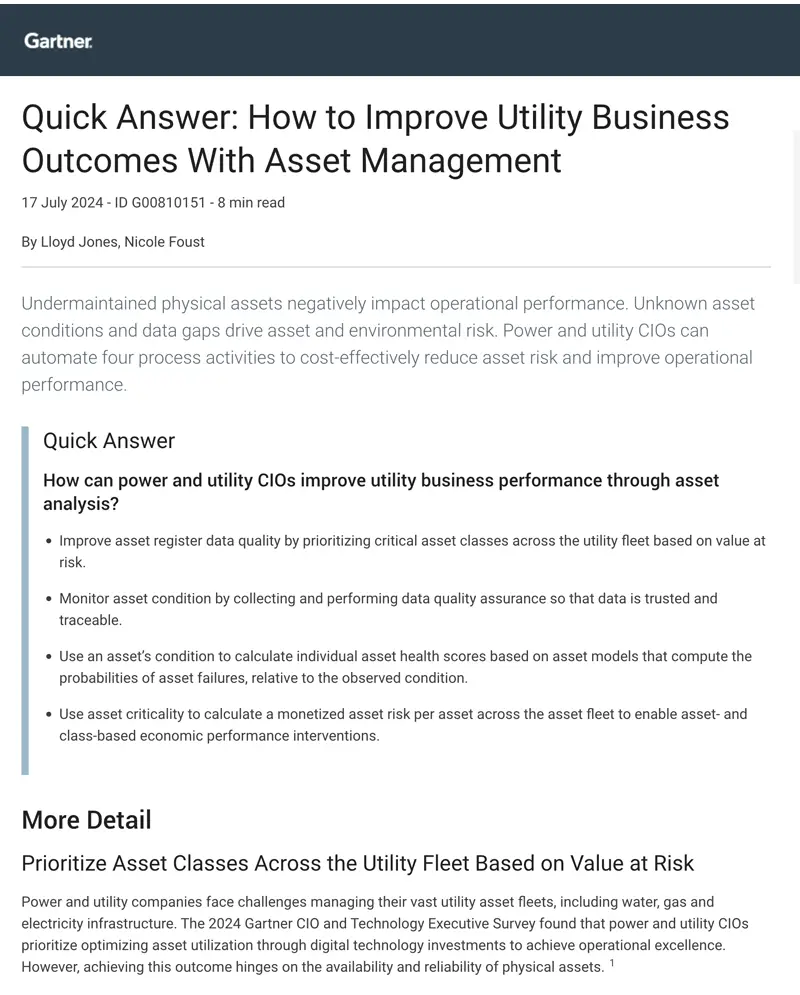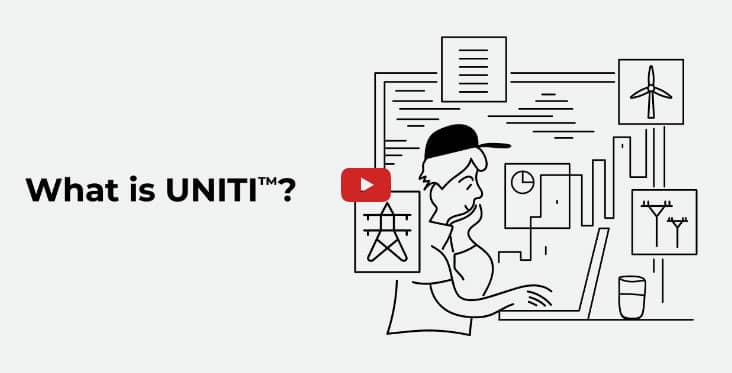Improved agility is now a focus for modern electric utilities as they take on the myriad challenges of infrastructure modernization, data management, and regulatory compliance. Old legacy systems cannot be integrated, adapted or scaled with modern tech. This means utilities are left reactive, error prone, and slow to respond, which ultimately compromises grid reliability and increases operational costs.
Composable architectures offer a compelling alternative, enabling trouble-free integration across disparate systems and promoting cross-functional collaboration. Modular, asset-centric platforms like UNITI Workspace can help utilities to remove or avert operational bottlenecks, as well as helping field teams and decision-makers to work together more coherently.
2024 Gartner® Quick Answer: How to Improve Utility Business Outcomes With Asset Management
To download your copy of this helpful guide, submit the form below and we will send it to your inbox.

Problems With Legacy Systems in Transmission Operations
Legacy systems are traditional, tightly integrated software platforms where all functionalities—such as asset management, outage scheduling, inspection tracking, and maintenance planning—are bundled into a single, centralized framework. These systems are rigid and inflexible, often requiring significant downtime or costly modifications to add new features or integrate with external tools.
They rely on proprietary data formats and closed architectures, making interoperability with modern technologies like IoT sensors, AI-driven analytics, or third-party APIs difficult.
For instance, a system designed to handle substation diagnostics may not communicate effectively with one managing line inspections, leading to redundant efforts and delayed decision-making. This fragmentation limits the ability to respond to dynamic grid conditions, such as fluctuations in demand or unplanned outages.
The inability to synchronize data across systems hampers predictive maintenance efforts, as engineers must manually reconcile data from disparate sources to identify potential issues.
Removing Bottlenecks
An IEA study suggested that the world must add or replace 80 million kilometers in the grid by 2040 or risk slowing down the energy transition, affecting energy security. In the same report, Fatih Birol, Executive Director of IEA, warned the grid is at risk of developing a bottleneck.
Monolithic systems also create bottlenecks in scaling operations, particularly in transmission networks with geographically dispersed assets. For instance, a utility company managing thousands of miles of transmission lines across diverse terrains may rely on inflexible, outmoded software for outage scheduling.
This system might only allow limited users to access critical scheduling tools simultaneously, slowing down response times during emergencies. The use of proprietary hardware or software environments means that updating or expanding their functionality demands expensive vendor-specific upgrades.
A practical example can be seen in the Midwest United States, where a utility company faced prolonged outage restoration times due to the inability of its legacy systems to integrate real-time weather data with asset failure predictions. Field teams had to manually retrieve weather updates from external sources and correlate them with asset conditions—causing hours-long delays.
Composable Architectures: The Building Blocks of Flexibility
Instead, composable architectures introduce modularity into utility operations by breaking down functionalities into discrete, interoperable components. This approach allows utilities to integrate and scale new technologies without overhauling existing systems.
For example, platforms like UNITI Workspace enable real-time collaboration by aggregating data from multiple sources—such as IoT sensors, GIS systems, and drone imagery—into a single, accessible interface. By employing an asset-centric design, UNITI ensures that all data is anchored to specific physical infrastructure, enabling targeted analysis and actionable insights.
This modularity is particularly beneficial in dynamic scenarios such as storm recovery. For instance, utilities are leveraging systems to combine weather forecasts, asset health analytics, and crew availability to optimize operations during extreme weather events.
Composable architectures also enable utilities to adopt new technologies incrementally. For example, Deloitte reported on a U.S. utility that integrated drone inspections with GIS platforms to reduce vegetation risks, automating the detection of at-risk vegetation and improving grid reliability.
Composable systems make cross-functional collaboration far easier. With asset-centric platforms like UNITI Workspace, engineers, operations managers, and field teams can work from the same interface, accessing real-time asset data, annotations, and inspection results. This transparency improves decision-making, as stakeholders no longer rely on fragmented updates from disparate departments.
The Role of APIs in Enhancing Interoperability
Application Programming Interfaces (APIs) are foundational to composable architectures, allowing disparate systems to communicate seamlessly. For transmission utilities, this means integrating specialized tools—such as fault detection algorithms or load forecasting models—into broader operational workflows.
The UNITI Connect API exemplifies this capability by enabling utilities to trigger event-based activities, such as initiating work orders or generating risk assessments, directly from aggregated data.
The World Energy Outlook 2024 emphasizes how advanced data integration, real-time analytics, and API-driven technologies can optimize energy management systems and significantly improve operational efficiency.
According to a recent survey of 863 C-level executives and VPs from utility companies worldwide, 84% of them viewed data analytics as crucial to digital transformation—a focus that stems from aging infrastructure and increasingly complex assets.
UNITI’s Connect API demonstrates the functionality of composable systems by enabling event-based triggers such as generating work orders when asset health metrics drop below a certain threshold. This eliminates time-consuming manual intervention, ensuring that maintenance workflows begin as soon as risks are detected.
Overcoming Implementation Challenges
Transitioning to a composable architecture is not without its challenges. Utilities must address concerns such as data security, legacy system compatibility, and workforce adaptation.
Security is particularly critical, as the integration of multiple systems increases potential vulnerabilities. Solutions like UNITI employ end-to-end encryption and access controls to safeguard sensitive information, aligning with standards set by organizations like NERC.
Compatibility with legacy systems is another hurdle, requiring careful planning and phased implementation. For example, the adoption of Common Information Model (CIM) standards has been instrumental in harmonizing data structures across utilities.
By enabling incremental upgrades rather than wholesale replacements, composable architectures allow utilities to modernize at a manageable pace.
Workforce adaptation involves retraining personnel to utilize new systems effectively. Utilities have found success by deploying user-friendly interfaces and providing hands-on training sessions, reducing resistance to change and accelerating adoption.
Benefits for Transmission Networks
The advantages of composable architectures extend beyond operational efficiency. By centralizing data and fostering collaboration, these systems improve grid reliability and resilience. Research shows that drone inspections can reduce inspection times by as much as 70%, partly due to the ability to automatically integrate drone and satellite data into maintenance schedules.
This approach minimizes the likelihood of catastrophic failures, while optimizing resource allocation.
Furthermore, composable systems enhance scalability, allowing utilities to incorporate emerging technologies such as edge computing and AI-driven analytics. These advancements enable more granular monitoring of grid conditions, facilitating real-time adjustments to maintain stability during peak demand periods.
Future Outlook: A Collaborative and Modular Grid
As the energy sector continues to adapt, composable architectures look set to play a pivotal role in shaping the future of transmission operations. By enabling utilities to integrate new technologies rapidly and cost-effectively, these systems provide the flexibility needed to adapt to changing grid conditions.
In the coming years, advancements in machine learning, blockchain, and distributed computing will further enhance the capabilities of composable platforms, enabling utilities to transition from reactive maintenance to predictive and condition-based operations.
In conclusion, composable architectures offer a transformative approach to utility operations, addressing the limitations of traditional systems and paving the way for a more agile, data-driven future. By embracing modularity and interoperability, utilities can achieve greater efficiency, resilience, and adaptability in managing their transmission networks.



